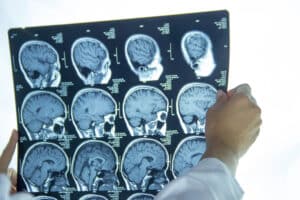
Most cases of locked in syndrome occur because of damage to the brainstem. The brainstem is near the base of the skull, connecting the cerebrum with the spinal cord. It controls many autonomic functions as well as providing a pathway for motor and sensory neurons to travel between the brain and the spine.
In locked in syndrome, the brainstem is affected in such a way that it no longer functions properly. An injury to this area of the brain can affect motor and sensory transmissions, leading to global paralysis except for blinking and vertical eye movements. Some people also experience issues with some autonomic functions such as breathing and swallowing.
Understanding the Causes of Locked In Syndrome
The primary cause of locked in syndrome is damage to the brainstem. This damage affects the way motor and sensory neurons travel between the brain and spinal cord, preventing them from passing through or limiting their ability to do so. This explains why some people regain small movements while others experience global paralysis for the rest of their lives.
Lack of blood flow (stroke) or a major brain bleed (hemorrhage) are the two most common conditions that lead to locked in syndrome. When these conditions affect the brainstem, they can lead to problems with:
- Motor function
- Sensory function
- Autonomic functions
This is why the patient suffers paralysis, has no reflexive reactions and may have problems with spontaneous breathing. Damage to the brainstem may also occur because of other injuries or illnesses. This may include:
- Traumatic injuries
- Tumors
- Infection
- Conditions that affect the motor neurons or the myelin sheath
- Poisoning or venom
Signs and Symptoms of Locked In Syndrome Caused By Brainstem Damage
When a person suffers brainstem damage and develops locked in syndrome, there are many signs and symptoms he or she may experience. Family members are often the first to recognize awareness and cognition in patients with locked in syndrome. The most common symptoms include:
- Quadriplegia and global paralysis
- Ability to blink eyes and make vertical eye movements
- Full awareness and cognition
- No response to painful stimuli
- May lack autonomic functions such as breathing and swallowing
- Retains the ability to see and hear
If you suspect your loved one is in a pseudocoma state and is aware of their environment following a stroke or brain injury, notify their doctor as soon as possible. Their doctor can evaluate their brain activity and determine their level of cognition.
Getting an updated diagnosis will allow their medical care team to offer communications options and work toward the best possible quality of life. Knowing you are aware of their condition will also bring relief to your loved one.
Treatment and Care of Those with Locked In Syndrome
There is no standard treatment or cure for locked in syndrome. Damage to the brain stem typically does not heal. In classic locked in syndrome, the patient suffers global paralysis except being able to blink the eyes and make vertical eye movements.
In patients who retain or recover horizontal eye movements, there is reason to believe he or she suffered an incomplete injury and may recover mobility in additional parts of their body. However, this is often insignificant. He or she may recover movement or a small range of motion in a single finger or foot. An incomplete injury may be possible even in patients who do not recover horizontal eye movements in the first days or weeks following the brainstem injury.
Significant recovery is extremely rare although there have been news reports of some people who seem to have recovered from what was initially diagnosed as locked in syndrome.
Improving Quality of Life for Those with Locked In Syndrome
Quality of life is the top concern for the family of those with locked in syndrome. Most medical care focuses on preventing opportunistic infections such as pneumonia and pressure sores. Also, doctors and therapists can prescribe special tools and devices to help with communication and mobility.
Specially designed power wheelchairs, lifts, stair lifts, and hospital beds are must-haves for families who want to care for their loved one at home. Communication devices also make it possible for those with locked in syndrome to interact with their loved ones and the outside world. Eye gaze devices and brain-computer interfaces are the two go-to communication devices for those with classic locked in syndrome.
Pursuing Damages for Brainstem Injury and Locked In Syndrome
In some cases, you may be able to pursue damages on your loved one’s behalf following a brainstem injury and locked in diagnosis. This is most common if your family member suffered a traumatic brain injury or was a victim of medical malpractice. The team from Newsome | Melton offers free case reviews and can help you understand your options.
Call us today at (800) 917-5888 for a complimentary consultation.
